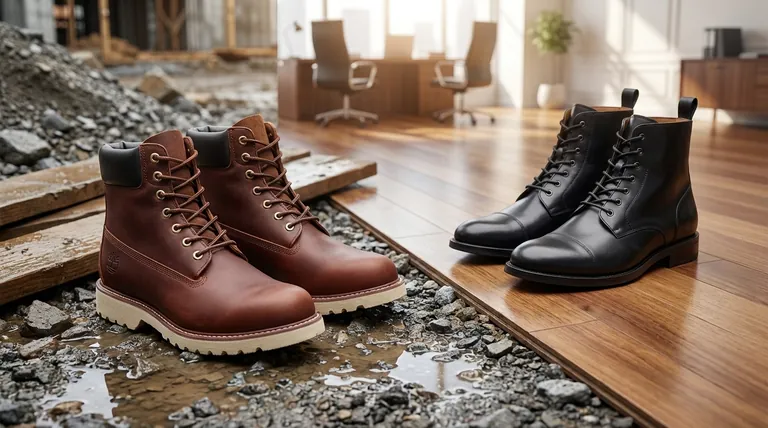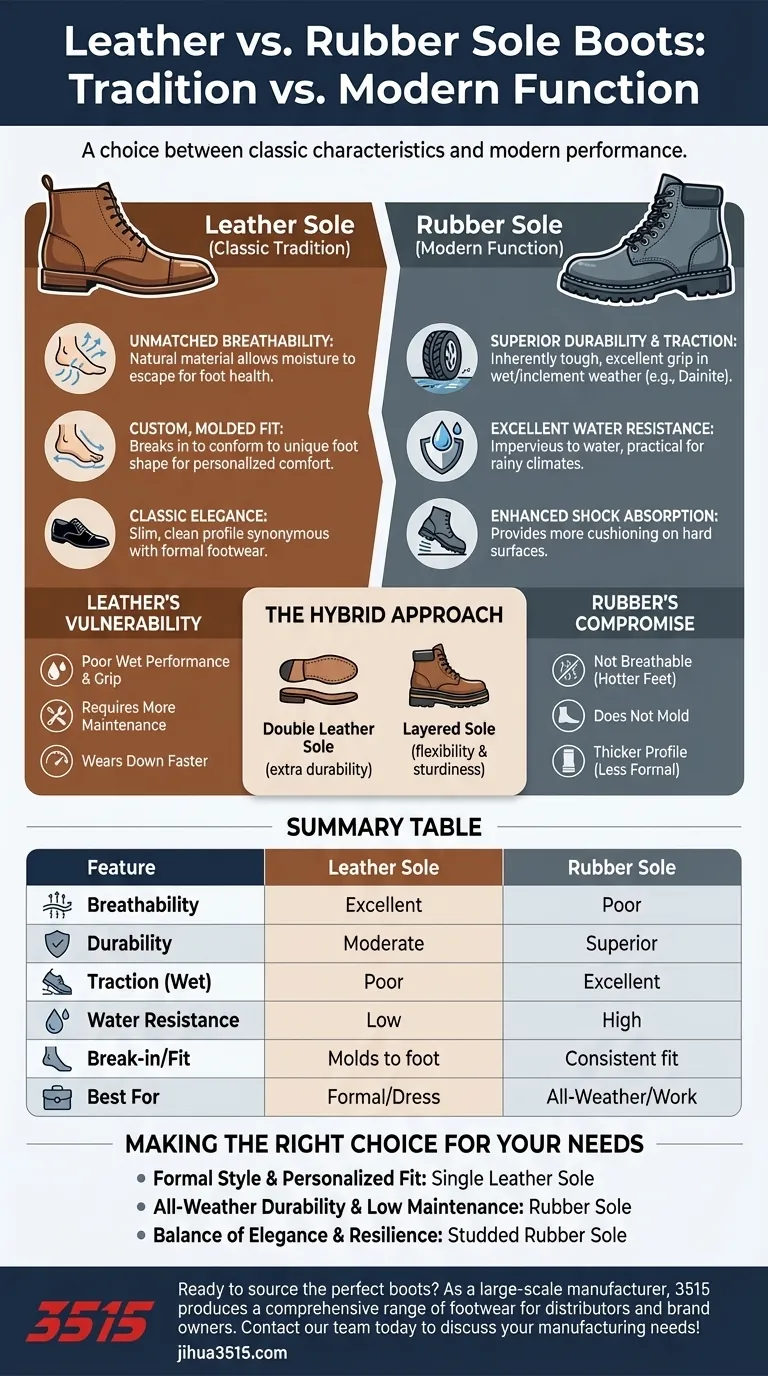At its core, the difference between leather and rubber sole boots is a choice between classic tradition and modern function. Leather soles are prized for their breathability and ability to mold to your foot for a custom fit, while rubber soles offer superior durability, traction, and water resistance right out of the box.
The decision is not about which material is universally "better," but which is better suited for your specific environment and purpose. Leather prioritizes personalized comfort and elegance, whereas rubber delivers practical, all-weather resilience.

The Case for the Leather Sole
A leather sole is the traditional foundation of high-quality footwear, valued for characteristics that have been refined over centuries.
Unmatched Breathability
Because leather is a natural, porous material, it allows moisture to escape from the boot. This breathability is crucial for foot health and comfort, especially during long days of wear.
A Custom, Molded Fit
The most celebrated quality of a leather sole is its ability to break in and conform to the unique shape of your foot over time. This creates a personalized, glove-like fit that is difficult to replicate with synthetic materials.
The Mark of Classic Elegance
Leather soles offer a slim, clean profile that is synonymous with formal and business footwear. Their sleek appearance provides an unmatched level of elegance for dress boots.
The Strengths of the Rubber Sole
Rubber soles were developed to overcome the practical limitations of leather, offering a modern solution focused on performance and longevity.
Superior Durability and Traction
Rubber is inherently more durable and abrasion-resistant than leather. Soles like the studded Dainite design provide excellent grip in wet or inclement weather where leather would become dangerously slick.
Excellent Water Resistance
Unlike leather, which can be damaged by excessive moisture, rubber is impervious to water. This makes it the far more practical choice for rainy climates or unpredictable conditions.
Enhanced Shock Absorption
Rubber naturally provides more cushioning and shock absorption than a stiff leather sole. This can lead to greater comfort when walking on hard surfaces like concrete sidewalks.
Understanding the Trade-offs
Choosing a sole material requires acknowledging the inherent compromises of each option. Neither material is perfect for every situation.
The Leather Sole's Vulnerability
The primary drawback of leather is its poor performance in wet weather. It lacks grip and can be permanently damaged by water if not cared for properly. It also requires more maintenance and will wear down faster on harsh surfaces.
The Rubber Sole's Compromise
While practical, rubber soles are not breathable, which can lead to hotter, sweatier feet. They also do not mold to the foot in the same way as leather, and their often-thicker profile can appear less formal or elegant.
The Hybrid Approach
Some bootmakers offer solutions that seek the best of both worlds. A double leather sole adds durability for harsher conditions, while a layered sole with both leather and rubber components can offer a balance of flexibility and sturdiness.
Making the Right Choice for Your Needs
Your decision should be guided entirely by how and where you plan to wear your boots.
- If your primary focus is formal style and a personalized fit: A single leather sole is the classic and most appropriate choice for office or dress environments.
- If your primary focus is all-weather durability and low maintenance: A rubber sole is the superior practical solution for daily commuting and unpredictable conditions.
- If your primary focus is a balance of elegance and resilience: Consider a Dainite or other studded rubber sole that provides weather-proof traction with a more streamlined profile than a heavy lug sole.
Ultimately, choosing the right sole means equipping your footwear to succeed in your intended environment.
Summary Table:
| Feature | Leather Sole | Rubber Sole |
|---|---|---|
| Breathability | Excellent | Poor |
| Durability | Moderate | Superior |
| Traction (Wet) | Poor | Excellent |
| Water Resistance | Low | High |
| Break-in/Fit | Molds to foot | Consistent fit |
| Best For | Formal/Dress | All-Weather/Work |
Ready to source the perfect boots for your market?
As a large-scale manufacturer, 3515 produces a comprehensive range of footwear for distributors, brand owners, and bulk clients. Whether you need elegant leather-soled dress boots or rugged rubber-soled work boots, our production capabilities encompass all types of shoes and boots to meet your specific demands.
Contact our team today to discuss your manufacturing needs and get a quote!
Visual Guide

Related Products
- Wholesale Leather Work Boots with Customizable Wedge Sole for Brands
- Durable Leather Tactical Boots Wholesale & Custom Manufacturing for Brands
- Durable Leather Work Boots for Wholesale & Custom Manufacturing
- Durable Leather Work Boots for Wholesale & Custom OEM Manufacturing
- Durable Leather Work Boots Wholesale Manufacturer & Custom Factory
People Also Ask
- What protection do leather work boots need? A Complete Guide to Material Care and Worker Safety
- What maintenance tips are recommended for leather safety footwear? Extend Lifespan & Preserve Safety
- What is the complete process for deep cleaning leather work boots? A Step-by-Step Guide to Preserve Your Investment
- What are the advantages of leather uppers in work boots? Unmatched Durability & Protection
- What type of boots are suitable for challenging weather conditions in a business setting? | Durable & Professional Footwear



















